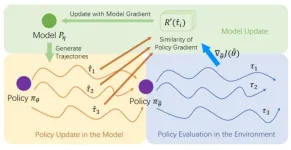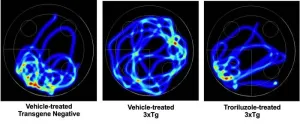Can you identify the new threat attracting Gen Z to nicotine use?
Survey finds just 1 in 4 adults could identify nicotine pouches if they saw them, but they are skyrocketing in popularity
2024-09-04
(Press-News.org) COLUMBUS, Ohio – About half of adults can identify cigarettes and e-cigarettes, but just one in four would recognize oral nicotine pouches, and these easily available products are growing increasingly popular among teens and young adults, according to a recent study commissioned by The Ohio State University Comprehensive Cancer Center – Arthur G. James Hospital and Richard J. Solove Research Institute (OSUCCC – James).
Oral nicotine pouches are small packets filled with a flavored powder containing nicotine and other chemicals that are tucked between the lip and gums. Researchers at the OSUCCC – James Center for Tobacco Research are concerned that these oral nicotine pouches are so appealing and easy to use that they could be a gateway to future tobacco product addiction for Gen Z.
Epidemiologist Brittney Keller-Hamilton, PhD, says these products are available in low- and high-nicotine concentrations, making them appealing to both new users and people who are already addicted to nicotine.
“We're starting to hear from college students that they find it easier to use nicotine pouches at work or in class because they are easier to conceal. They also do not require you to spit excess saliva like older tobacco oral products (dip, snuff),” said Keller-Hamilton, who studies nicotine pouch use and regulation at the Center for Tobacco Research. “One of my biggest concerns with nicotine pouches is that as youth experiment with these products, they might not find them to be satisfying enough to continue to meet a growing nicotine craving and then might transition to more harmful products.”
She notes that regulation of these products is minimal, and that removing flavorings, prohibiting online sales, and increasing the price could discourage youth experimentation and, therefore, reduce their risk of becoming addicted to nicotine.
As students go back to school, Keller-Hamilton cautions parents to pay attention to what is in their teenagers’ backpacks.
“Many products are cleverly packaged to conceal the real content – vapes as highlighters or pens, oral nicotine pouches as mints. Unfortunately, due to loose industry regulation, they are very easy to obtain for underage youth, and they are far from harmless. We know that when people start using any nicotine product, including nicotine pouches, before their brain is finished developing, it primes their brain for a stronger nicotine addiction and also primes their brain for addiction to other substances,” said Keller-Hamilton. “It’s really important for parents to talk with their kids about the dangers of these products and seek help from their pediatrician if they’re concerned about nicotine addiction.”
Study results and methods
For this survey, 1,000 adults aged 18 or older were asked about their ability to recognize nicotine products with and without the visual aid of packaging, as well as their perceptions about the health effects of these products.
Ohio State’s recent survey showed that 70% of adults believe nicotine pouches are harmful to health and lead to addiction, but just 25% say they could identify a nicotine pouch out of its container or packaging. The survey also found that those between the ages of 18-29 are more likely to know someone who uses nicotine pouches, as opposed to older adults.
This study was conducted on behalf of the OSUCCC – James by SSRS on its Opinion Panel Omnibus platform. The SSRS Opinion Panel Omnibus is a national, twice-per-month, probability-based survey. Data collection was conducted from July 19-22, 2024, among a sample of 1,008 respondents. The survey was conducted via web (n=976) and telephone (n=32) and administered in English. The margin of error for total respondents is +/- 3.5 percentage points at the 95% confidence level. All SSRS Opinion Panel Omnibus data are weighted to represent the target population of U.S. adults ages 18 or older.
To learn more about research at the Center for Tobacco Research, visit cancer.osu.edu/CTR. For resources on nicotine use and cessation in youth, visit tobaccofreekids.org. Adult smoking cessation support is available at The Ohio State University Wexner Medical Center. To schedule an appointment, call 614-293-QUIT (7848) or visit medcenter.osu.edu.
##
END
ELSE PRESS RELEASES FROM THIS DATE:
2024-09-04
Introduction
As a new degree of freedom, the orbital angular momentum of electromagnetic waves exceeds the traditional frequency, phase, and amplitude, and is expected to promote the infinite expansion of channel capacity. Recently, a team of research professor Chao-Hai Du from Peking University and Professor Xiaofei Zang's research group from the University of Shanghai for Science and Technology have carried out in-depth cooperation. Based on the research foundation of both sides in the field of terahertz and metasurface, a new method of generating polarization-multiplexed terahertz vortex combs using all-silicon metasurface has been ...
2024-09-04
Recently, model-based reinforcement learning has been considered a crucial approach to applying reinforcement learning in the physical world, primarily due to its efficient utilization of samples. However, the supervised learned model, which generates rollouts for policy optimization, leads to compounding errors and hinders policy performance. To address this problem, the research team led by Yang YU published their new research on 15 August 2024 in Frontiers of Computer Science co-published by Higher Education ...
2024-09-04
Since the first industrial revolution, the rapid development of the human economy and society has directly exacerbated the process of CO2 emission from human activities such as fossil fuel combustion, industrial processes, agriculture, and land use activities. With the continuous increase of global greenhouse gas concentration dominated by CO2, the greenhouse effect is becoming more and more obvious, and the trend of global warming is becoming more and more serious. To cope with the continuous warming of the global climate and mitigate ...
2024-09-04
Combine cyberbullying, smartphone use, lack of sleep and poor mental health, and you have the perfect storm for a teenage meltdown.
Australian researchers have polled more than 50,000 primary and secondary school students aged 7-19 years about the link between their sleep and nighttime phone habits, experience of cyberbullying and stress levels.
Researchers from the Behaviour-Brain-Body Research Centre at the University of South Australia found that across all genders and age groups, phone use overnight not only robbed children of sleep, but it also had a negative impact on their mental health, ...
2024-09-04
AUBURN, AL — In a recent development in Alzheimer's disease research, Auburn University scientists have studied a new drug, troriluzole, that can prevent brain changes leading to memory loss and cognitive decline in a mouse model of the disease. This study, recently published in the Journal of Neurochemistry, is the first to show how troriluzole can target early-stage alterations associated with Alzheimer’s, providing new hope for potential treatments.
Dr. Miranda Reed, a Professor in the department ...
2024-09-04
Pennington Biomedical Research Center’s Dr. Jeff Keller is evaluating the potential for delta-9-tetrahydrocannabinol, or THC, and cannabidiol, or CBD, to reduce the behaviors indicating agitation, distress or anxiety in patients with Alzheimer’s disease or other forms of dementia. The study is designed for hospice-eligible patients who are either receiving hospice care or who are eligible for hospice, and who are exhibiting agitation concurrently with a diagnosis of dementia. There are currently no FDA-approved medications to treat agitation at the end-of-life stages in dementia patients.
The “Life’s End Benefits of Cannabidiol and ...
2024-09-04
URBANA, Ill. — The National Science Foundation (NSF) has funded University of Illinois Urbana-Champaign research that aims to connect the dots between quantitative and molecular genetics and improve crop breeding.
The four-year, $795,000 grant investigates new theories on how genetics influence complex crop traits, such as yield or grain quality. These traits are controlled by lots of different genes — sometimes hundreds or thousands — which makes untangling their contributions difficult. Crop breeders use a host of advanced genetic tools to predict and ...
2024-09-04
Boston – CDK4/6 inhibitors, which are already FDA approved for the treatment of other forms of cancer, show early signs of promise in the treatment of a subtype of pediatric high-grade glioma, according to new research from Dana-Farber Cancer Institute and the Institute of Cancer Research in London. Treatment of a patient with a second relapse of this glioma subtype and no other treatment options resulted in 18 months of progression-free survival.
“We are finally starting to see more targeted therapies come out for different forms of brain cancer,” says senior author Mariella Filbin, MD, PhD, co-director ...
2024-09-04
A recent study shows social media influencers are more important than previously thought when it comes to getting out vital information in a crisis.
The study suggested partnerships that could improve public communication between governments, non-profits and social media influencers during crises. The study, conducted by UF/IFAS assistant professor Kimberly Kay Wiley, a researcher in the family, youth and community sciences department, and Bridgewater State University associate professor Seth Meyer, shows how these groups can collaborate to effectively disseminate information and manage public health emergencies on social media.
“In ...
2024-09-04
The ability to cope well with, and adapt to, challenging life circumstances and events in older age is linked to a lower risk of death, suggests a large nationally representative study, published in the open access journal BMJ Mental Health.
The findings underscore the importance of efforts to bolster mental resilience, conclude the researchers.
The available evidence suggests that mental resilience is a dynamic and active process influenced by various factors, including sex, hormones, and the genes regulating ...
LAST 30 PRESS RELEASES:
[Press-News.org] Can you identify the new threat attracting Gen Z to nicotine use?
Survey finds just 1 in 4 adults could identify nicotine pouches if they saw them, but they are skyrocketing in popularity







